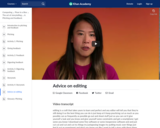
Adding a tail. Created by Karl Wendt.
- Subject:
- Applied Science
- Engineering
- Material Type:
- Lesson
- Provider:
- Khan Academy
- Provider Set:
- Khan Academy
- Author:
- Karl Wendt
- Date Added:
- 02/18/2013

Adding a tail. Created by Karl Wendt.

An overview of Adding an event listener

In this video we explore how to derive the demand for a factor of production based on how productive that factor is and how much additional revenue that factor brings in. Created by Sal Khan.

Learn how to add event listeners in jQuery so that your JavaScript can respond to events on the page, like when a user clicks a button or drags an image.

To add the vectors (x₁,y₁) and (x₂,y₂), we add the corresponding components from each vector: (x₁+x₂,y₁+y₂). Here's a concrete example: the sum of (2,4) and (1,5) is (2+1,4+5), which is (3,9). There's also a nice graphical way to add vectors, and the two ways will always result in the same vector.

Explore the mechanics of adjustable rate mortgages (ARM) in this video, including how they work and in what situation an ARM might be advantageous and when it might work against you.

Hear about how respect for Earth can help us attain a more sustainable lifestyle in the face of climate change in this video segment adapted from United Tribes Technical College.

The following module consists of a PowerPoint presentation, two lab sheets, and a syllabus for modifying automotive engine courses to include HEV technologies and was developed through a seed grant from the CAAT. The PowerPoint discusses the application of variable valve timing (VVT) and Atkinson cycle principals to HEVs, and the extra hydrocarbon capturing devices added to HEVs due to the use VVT and Atkinson principles. The lab "Compression Testing VVT systems" reinforces the ideas of the presentation illustrating engine malfunctions caused by a faulty VVT system. For additional insight on HEV engine service procedures, an oil change lab sheet for HEVs is included. For educators looking to modify current courses, the syllabus has highlighted fields where HEV technologies were incorporated to an engines course at Lewis and Clark Community College.

This resource was developed through a seed grant from the CAAT and discusses the advanced air conditioning systems placed in HEVs and safety precautions to follow when servicing them. These systems are high voltage A/C compressors and the components controlling them (A/C ECU, HV ECU, and Converter Control Circuit). Safety precautions discussed include Class 0 insulated gloves, insulated tools, color coding of wire looms to indicate voltage, CAT III and IV multimeter use, and properly disabling high voltage circuits. For educators looking to modify current courses, a syllabus is included with highlighted fields where HEV systems and safety were incorporated into an existing automotive heating and cooling course at Lewis and Clark Community College.

Some advice from our storytellers.

More advice to new writers.

Advice on editing.

Advice for storytellers.

Advice from storytellers on structure.

Advice from our storytellers.

What affirmative action is in the United States and major legal cases and initiatives surrounding it. Coverage of Regents of the University of California v. Bakke, Grutter v. Bollinger, and Proposition 209 in California.

EDSITEment! and National Endowment for the Humanities presents this resources recognizing one of the heroes of the Battle of Bunker Hill, Salem Poor, an African American. Black people fought on both sides during the American Revolution. Census data also reveal that there were slaves and free Blacks living in the North in 1790 and after. What do we know about African-American communities in the North in the years after the American Revolution?

Students use Library of Congress primary sources to examine how African-Americans in the Gilded Age were able to form a meaningful identity for themselves and reject the inferior images fastened upon them.

Students use Library of Congress primary sources to examine how African-Americans in the Gilded Age were able to form a meaningful identity for themselves and reject the inferior images fastened upon them.

We've learned about demand for a good or service, but aggregate demand is different: its the demand for everything bought in an economy. In this video, we discuss how aggregate demand (AD) is different from demand and why aggregate demand is downward sloping. Created by Sal Khan.